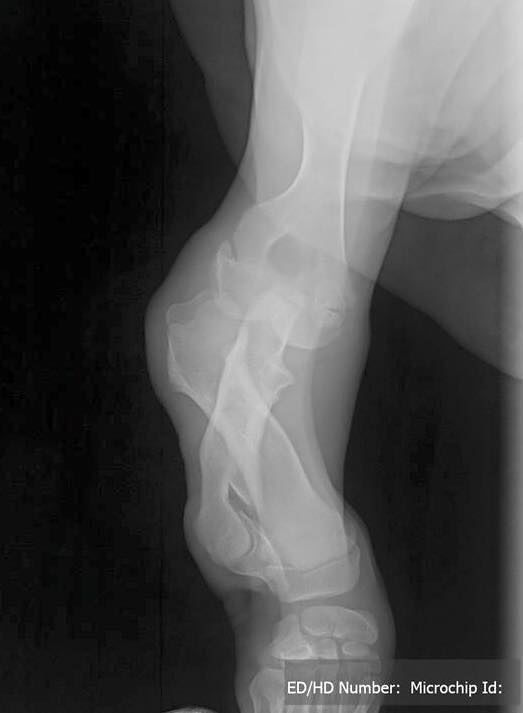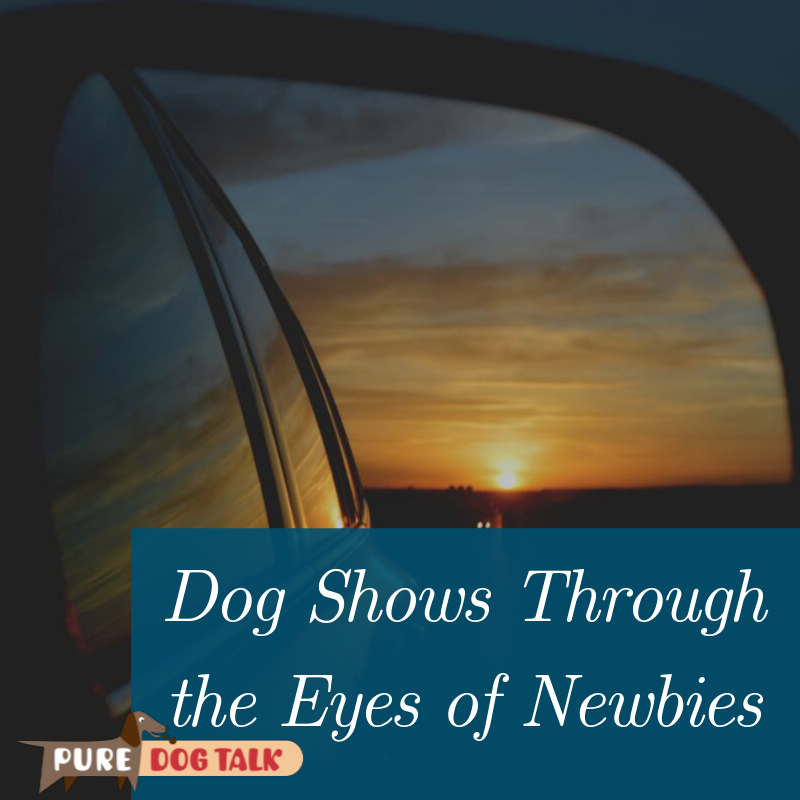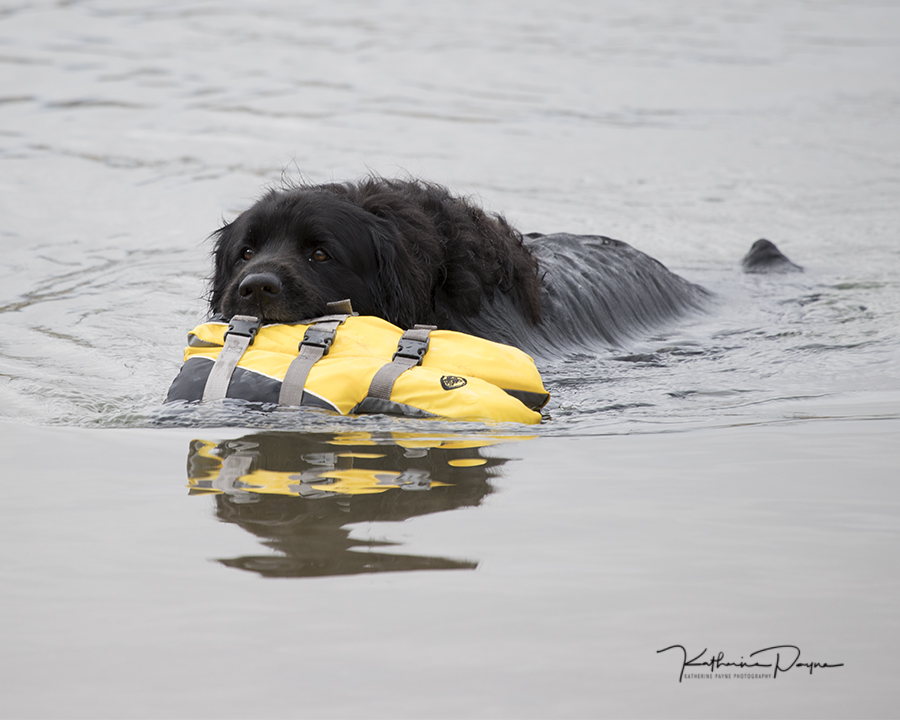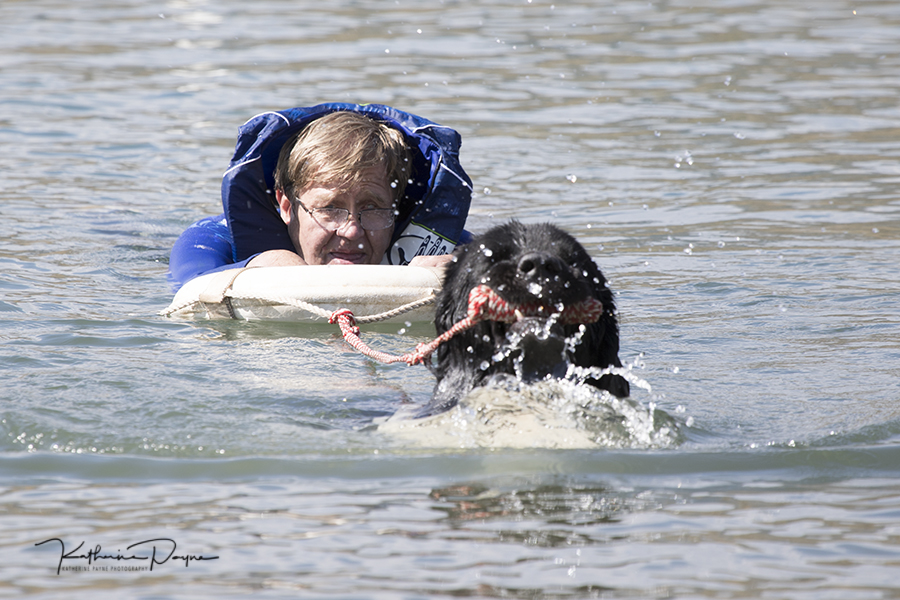339 – Crowd Sourcing Knowledge of Devastating Disease
Crowd Sourcing Knowledge of Devastating Disease
Barb Jenness, chair of the Newfoundland Club of America Forelimb Anomaly Committee, joins host Laura Reeves to talk about the crowd sourcing their group is doing to identify and research this little-known but crippling disease.
A 1981 case study conducted in Norway first described the condition:
ABSTRACT
A description of a litter of Newfoundland dogs of which six out of seven puppies suffered from, more or less, deformation of the elbow joints, is presented. The two male dogs were, because of the condition, destroyed at 20 weeks of age. The patho-anatomical examination revealed abnormalities of the joint cartilage of all the major joints of the extremities. The condition is described as a generalized fibroid, proliferative degeneration of the joint cartilage.
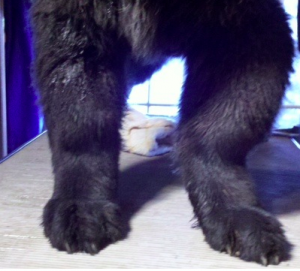
Photo courtesy of NCA Charitable Trust, Forelimb Anomaly Committee.
Jenness said puppies affected with FLA “their front legs bow out. It’s not dwarfism, but that’s what it looks like. Dwarfism affects all the legs, this is just the front legs.”
According to the FLA website: “We believe it is not viral, bacterial, caused by rapid growth, or a specific diet. Most researchers believe it is genetic but the exact mode of inheritance is unknown.”
The defect is often not recognized until eight to 12 weeks of age and the puppies may be in their new homes before anyone determines there is a problem, Jenness said.
Not Just Newfoundlands
A current study, and working with OFA, has enabled the Committee to identify other affected breeds, including Tibetan Mastiffs, Saint Bernards, Bernese Mountain Dogs, Nova Scotia Duck Tolling Retrievers and Chesapeake Bay Retrievers. Jenness noted that all of the breeds with affected puppies have some relation to the Newfoundland.
Jenness’ committee was established to create a clearinghouse of xrays and information because the disease is often undiagnosed or misdiagnosed. Her other primary goal is to “get the word out” to owners and club members so that if a puppy is affected, it’s xrays, DNA and case history can be added to the committee’s crowdsourcing approach to gathering data.
“Nobody wants to come face to face with such a crippling disease,” Jenness said, addressing the challenges of working with breeders on the problem. “Overcoming stigma is a challenge.”
Jenness said a test breeding was done in the ‘80s, before the availability of DNA and genetic testing available today. The test breeding mated two affected dogs, which produced zero affected progeny.
From that test, Jenness said, “We have determined it is not a simple recessive. At this point we believe it is a polygenic trait with a trigger that turns it on or off, although this still unconfirmed.”
“It’s hard to get studies funded that are focused on just one breed,” Jenness said. “As we’ve identified other breeds affected, we have ongoing studies and promising information is coming out. But we need more samples, more x-rays, more confirmed cases to be reported so we can add to the information.”
Anyone with questions or concerns about their dogs, or who would like to participate in the studies, contact Jenness at forelimbanomaly@gmail.com
314 – Dog Shows Through the Eyes of Newbies
Dog Shows Through the Eyes of Newbies
I was honored to visit with four brand “newbies” recently in a panel discussion format. These folks shared truly valuable information about what got them started, what they love and even what they don’t.
Huge thanks to listener Dr. Clifton Jamil Kenon Jr whose idea this was. The announcement on PureDogTalk’s FB page garnered 147 comments from folks who were so excited to share their experiences. I hope to make a continuing series of these types of conversations because the stories I received were so amazing.
Kenon, Kristin Eberly, Neil Trilokekar and Kayla Croteau represent a wide spectrum of the dog fancy. They share their fascinating journeys into the sport of purebred dogs, talk about mentors, what they love and what has been frustrating in each of their individual experiences.
Mentorship
“Meet people where they are,” Kenon advises mentors and would be mentors. “Everyone comes to the table with their own goals. This is a sport that lends itself to diversity.” Kenon’s mentor, Susan Giles, visited with me on the podcast just recently.
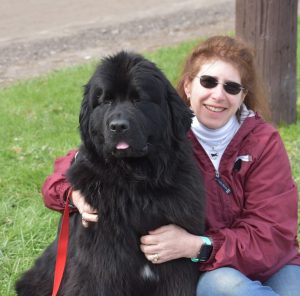
Kristin Eberly
The best help Eberly found is from her handling class instructor, who she says offers “criticism wrapped in something positive.”
Trilokekar said his mentors have encouraged him to study and think critically. “They share their knowledge without expecting me to be obedient,” he noted.
Croteau said her mentor is always open to the silliest of questions and is always positive.
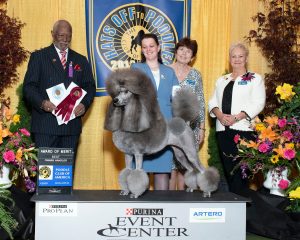
Kayla Croteau
Strongest encouragement
- “Set your own goals,” Kenon said. “Celebrate the wonderful people who help you get there. Ignore the people who want sink everybody’s ship. Don’t go broke doing it. Have fun.”
- “Don’t be afraid to ask for help,” Eberly offered. “Long time people in the breed can be intimidating. Those people will help you if you just ask.”
-
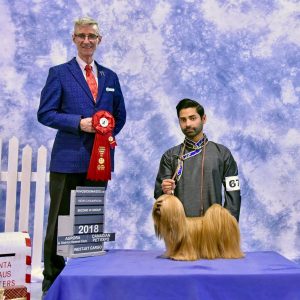
Neil Trilokekar
“Find your fascination,” Trilokekar encouraged. “So many facets you can be engaged by. Learn about history, and heritage of your breed. Go do other things with people when you’re at a dog show. Build a relationship. Never stop learning.”
- “Coming in it was pretty terrifying,” Croteau opined. “Remember we’re all here because we love the dogs. Set small goals. Don’t just come to the show, show and go home. Hang out. Have an open mind and big ears.”
119 – Heroic Newfoundland Dogs: Water Rescue with Lou Ann Lenner and Sue Raney
Heroic Newfoundland Dogs – Saviors of Seafarer and Fishermen
Every Christmas season brings to memory the heroic rescue of the 90 passengers and crew of the S.S. Ethie by a stalwart Newfoundland…It was more than 50 years ago, during a blizzard, that the Ethie was wrecked off the coast of Bonne Bay, Newfoundland. No boat could be launched on that stony shore during such a raging storm. There were more than 100 souls utterly helpless within sight of land.
All of them would have been lost and many would have been mourning families that Christmas, had not a Newfoundland and its owner appeared on the nearby shore. The dog went to the rescue upon an order from its master. The Newfoundland swam out through a sea in which no man could possibly have survived. The powerful dog made it to the ship and carried a lifeline back to shore. With this a buoy was rigged and all hands saved. Among the rescued passengers from the Ethie was an infant in a mail bag.” From The New Complete Newfoundland, Margaret Booth Chern, 1975
Developed in the eponymous islands off the east coast of Canada, the Newfoundland is an outstanding water dog. The dogs worked on fishing boats in the rugged, icy, stormy seas around their home island. While exact details of the progenitors of the breed are lost to history, written descriptions and paintings date back to the 1700s. Famed poet Emily Dickinson owned a Newfoundland and, of course, Sir Edwin Henry Landseer painted the breed frequently. In fact, the black and white color of the dog is known as a “Landseer” Newfoundland.
“Seamen” the Newfoundland Dog of Capt. Meriweather Lewis
Amongst the breed’s most well-known individuals is Seaman, Captain Meriweather Lewis’ dog, who accompanied President Thomas Jefferson’s exploration group during their rugged, three-year journey across what is now the United States in the early 1800s. Seaman was mentioned repeatedly in the journals of the Expedition, including saving the camp from a rampaging buffalo and retrieving game shot or wounded by the expedition’s hunters.
Today, the breed serves as a living embodiment of the culture of ships and fishing villages in Newfoundland. Proper coat and soundness are critical.
Lou Ann Lenner – Sun Valley Newfoundland Dogs
Our first guest Lou Ann Lenner, Sun Valley Newfoundlands, is a breeder of National and Regional specialty winners since 1977, with four generations of homebred ROM dogs.
According to Lou Ann, she always has bred to type, line breeding consistently, incorporating primarily Pouch Cove blood lines. Health can be a challenge as are the cycles in the quality of the breed. Long-term breeders *recognize* when quality is slipping and “step up” to get the breed back on track.
Maintaining type while managing health issues in the breed, specifically orthopedic problems associated with giant breed dogs and cardiac concerns is a primary concern. Lou Ann keeps only bitches in her kennel and reaches out for stud dogs to incorporate into the breeding program. Her top three qualities to when seeking a stud dog are balance, soundness, and a complementary pedigree.
She observes that the best home for a Newfoundland is someone who is committed to grooming and familiar with the breed. On a personal note, she only places puppies with owners who have someone to be home with the dog consistently.
Lou Ann strongly recommends learning about what’s behind your dog in terms of dogs in a pedigree, and honestly sharing what you know with new folks.
Sue Raney – Sweetbay Newfoundland Dogs and Water Rescue Work
Sue Raney, our second guest, is a Newfoundland fancier who has spent 25 years working dogs in water rescue work.
“The dogs have an amazing ability to be companions in water in a way no other breed does. They are just joyful to be around,” Sue said.
She notes that in a form follows function capacity, a dog’s effortless, fluid motion in the ring, translates to a powerful swimming stroke in the water. She also reminds people that the correct coat protects the dog in its native frigid water. The standard describes the coat as “flat, water-resistant, double coat that tends to fall back into place when rubbed against the nap. The outer coat is coarse, moderately long, and full, either straight or with a wave. The undercoat is soft and dense,…”
Titles with Meaning
The fascinating work the dogs do to earn titles through the national breed club includes water rescue exercises that demonstrate the breed’s heritage…. saving people, and saving “things” that have fallen overboard.
Sue says she encourages owners to become involved with regional breed clubs. Her enthusiasm for the work these dogs do is infectious!
Grooming Tip Of the Week with Allison Foley
Right Tools for the Job – Brushes
- Brushes: Pin brushes are different lengths. Think about what you are doing – the longer the hair, the longer the pin.
- Take good care of your brushes – preserve the pins. Bent or broken pins rip or break hair. Keep the brush in a box to protect it.
- Don’t put them in the top of your tack box and close the lid!
- Keep clean hair and product brushes separate. Mark your brush so you don’t put product residue onto a clean coat.

